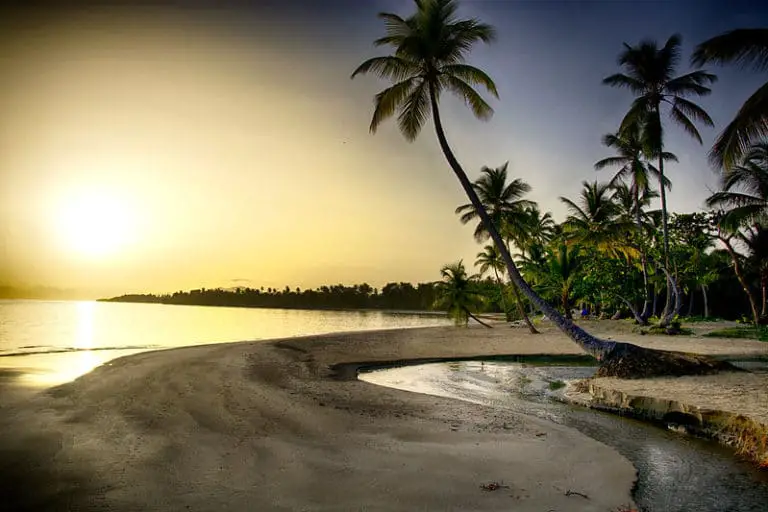Dwarf Gecko From The Dominican Republic, The World’s Smallest Lizard

This species of gecko is part of the genus Sphaerodactylus, endemic to the Dominican Republic. Its scientific name is Sphaerodactylus ariasae. It is one of the two smallest known reptiles in the world.
As stated in an article in the Caribbean Journal of Science, it is not only the world”s smallest known lizard, it is also considered to be the smallest of tens of thousands of different species of birds, reptiles and mammals.
This dwarf gecko species was discovered by two biologists from the United States in the Dominican Republic and is considered the smallest gecko in the world, the 1.6 cm long Jaragua Sphaero.
This species, which is threatened with extinction, lives in the park of Jaragua and on the island of Beata. This discovery illustrates the fact that we know only a small part of the species that populate the Earth.
This dwarf lizard is threatened with extinction. And this is what Michael Smith, a specialist in Applied Biodiversity Science, warns: “These unique species are threatened. If the Caribbean begins to lose its species at the current rate, one of the most relevant natural systems will be devastated in the coming years”.
Contents
Physical characteristics of the dwarf gecko

It measures 16 mm from the tip of the head to the beginning of the tail. It has a reddish head with whitish stripes on top, rounded brown eyes. The trunk is grayish with dark spots and light gray in the central region. The tail is long, relatively wide and slightly flattened, similar in color to the head.
Unfortunately, the habitat of this wonderful animal has been the target of natural predation so the existence of this lizard is in danger.
Jaragua Park, habitat of the dwarf gecko
The Jaragua Park is a true treasure of Dominican nature, both for its vegetation and its fauna, it has amazing biodiversity, but unfortunately, some of the animals found in this park are in danger of extinction, such as the dwarf lizard and the rhinoceros (Cyclura cornuta) and Ricord’s iguanas (Cyclura ricordi).
This park is a protected area, in this park, you can also see a lot of flamingos.
Among the variety of habitats that this National Park has, there are a number of lagoons, such as Oviedo, Bucan Salt Lake, Bucan de Base, Laguna Salada, La Rabiza, Manuel Matos, Puerto en Medio, among others.
The name Jaragua comes from the Taino Indians, for whom the area was part of the Xaraguá Chiefdom. It is the only protected part of the ancient geological formation known as Southern Paleoisland, one of the two that joined to form the current island of Hispaniola, between 20,000 and 30,000 years ago.
For this reason, it is also one of the few places in the country where vestiges of the aboriginal culture remain; they can be seen in a considerable number of caves that hold pictographs, petroglyphs and vessels.
Another dwarf lizard endemic to the Dominican Republic

The Lucia (Celestus costatus) or Hispaniolan smooth galliwasp is an endemic species of land lizard in the family Anguidae (glass lizards).
It inhabits almost the entire island from lowlands to mountainous areas. They are most common in broad-leaved forests where they live in the leaf litter and among the fallen logs.
Lucia Adults measure between 11 to 14 centimeters (body length). Males are larger than females.
It has an elongated body. The legs are small in relation to its body, but relatively large compared to other species of its genus.
Its back is metallic brown or cream, while the belly is white or gray. It presents very fine scales that offer a very shining aspect. One of its most distinctive characteristics is a black line on the sides that extends from its snout to the middle of its sides.
The Lucia is omnivorous and can feed on other smaller reptiles.
These small reptiles are very valuable
I did a little research online and found out that there are stores where they sell these reptiles at a cost of up to US$100 each.
Many reptile hobbyists buy this type of lizard, although I know that in the Dominican Republic this practice does not exist.
Anyway, it is good to know that these animals have a high value, not only economically, but also for their contribution to the local biodiversity.








Hello, my name is Jonathan and I’m spending a week in punta Cana and I found one of the smallest lizards right here in the resort., I don’t want him to get eaten, and I can’t take him home. What do you suggest I do? Can you come get him?
Hi Jonathan, did you find one? Wow, you are quite lucky, unfortunately, I am a bit retired from Punta Cana right now…
I have a little white lizard in my house, he is my pet, his name is “Cornelius”…well, actually it is not my pet, is just a lizard that appears from time to time and helps me, he eats ants and mosquitoes…
I recommend you to take the lizard to a leafy place, where there are a lot of bushes, the lizard knows how to take good care of itself if it is an adult.
If you found the lizard in that area, it means that it has a safe environment where it has been able to reproduce successfully.
Nice article! We live in Sosúa in an apartment on the ground level and backs up to the woods. We 10-15 that live around our windows and on our ceiling inside our hone at any given time. I had no idea the species was in danger since they seem to thrive in our home.
Hello, the endangered species is the Jaragua Sphaero, which is the image I put on the cover, the other species (Celestus costatus), is very similar to the first and inhabits without problems in some cities in the country.
Both are very valuable.